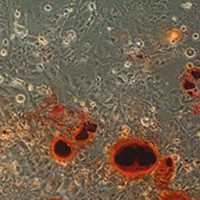Effects of rutin on osteoblast MC3T3-E1 differentiation, ALP activity and Runx2 protein expression

Submitted: 1 November 2020
Accepted: 17 December 2020
Published: 20 January 2021
Accepted: 17 December 2020
Abstract Views: 1871
PDF: 901
HTML: 24
HTML: 24
Publisher's note
All claims expressed in this article are solely those of the authors and do not necessarily represent those of their affiliated organizations, or those of the publisher, the editors and the reviewers. Any product that may be evaluated in this article or claim that may be made by its manufacturer is not guaranteed or endorsed by the publisher.
All claims expressed in this article are solely those of the authors and do not necessarily represent those of their affiliated organizations, or those of the publisher, the editors and the reviewers. Any product that may be evaluated in this article or claim that may be made by its manufacturer is not guaranteed or endorsed by the publisher.
Similar Articles
- C. Pellicciari, Histochemistry through the years, browsing a long-established journal: novelties in traditional subjects , European Journal of Histochemistry: Vol. 54 No. 4 (2010)
- F.M. Gomes, I.B. Ramos, C. Wendt, W. Girard-Dias, W. De Souza, E.A. Machado, K. Miranda, New insights into the in situ microscopic visualization and quantification of inorganic polyphosphate stores by 4',6-diamidino-2-phenylindole (DAPI)-staining , European Journal of Histochemistry: Vol. 57 No. 4 (2013)
- Rong Tian, Gengsheng Mao, Ghrelin reduces cerebral ischemic injury in rats by reducing M1 microglia/macrophages , European Journal of Histochemistry: Vol. 66 No. 1 (2022)
- Xiong Bing Li, Jia Li Li, Chao Wang, Yong Zhang, Jing Li, Identification of mechanism of the oncogenic role of FGFR1 in papillary thyroid carcinoma , European Journal of Histochemistry: Vol. 68 No. 3 (2024)
- J. Rieger, P. Janczyk, H. Hünigen, J. Plendl, Enhancement of immunohistochemical detection of Salmonella in tissues of experimentally infected pigs , European Journal of Histochemistry: Vol. 59 No. 3 (2015)
- G. Di Guardo, Lipofuscin, lipofuscin-like pigments and autofluorescence , European Journal of Histochemistry: Vol. 59 No. 1 (2015)
- T. Galbo, I. L Pedersen, T. Fløyel, C. H. Bang-Berthelsen, P. Serup, O. D Madsen, J. Hald, Novel monoclonal antibodies against Pdx1 reveal feedback regulation of Pdx1 protein levels , European Journal of Histochemistry: Vol. 54 No. 2 (2010)
- F Di Meglio, D Nurzynska, C Castaldo, A Arcucci, L De Santo, M de Feo, M Cotrufo, S Montagnani, G Giordano-Lanza, In vitro cultured progenitors and precursors of cardiac cell lineages from human normal and post-ischemic hearts , European Journal of Histochemistry: Vol. 51 No. 4 (2007)
- C. Pellicciari, Impact of Histochemistry on biomedical research: looking through the articles published in a long-established histochemical journal , European Journal of Histochemistry: Vol. 58 No. 4 (2014)
- H. Zhang, Y. Wang, J. Zhang, L. Wang, Q. Li, X. Sheng, Y. Han, Z. Yuan, Q. Weng, Testicular expression of NGF, TrkA and p75 during seasonal spermatogenesis of the wild ground squirrel (Citellus dauricus Brandt) , European Journal of Histochemistry: Vol. 59 No. 3 (2015)
<< < 6 7 8 9 10 11 12 13 14 15 > >>
You may also start an advanced similarity search for this article.

 https://doi.org/10.4081/ejh.2021.3195
https://doi.org/10.4081/ejh.2021.3195










